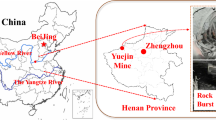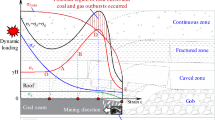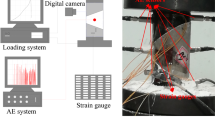Abstract
Mining-induced seismicity-triggered coal bursts (MISTCB) have become a major impediment to the safety of underground coal mining. Based on a severe MISTCB that occurred in China, this paper investigates the mechanism and control strategy of the MISTCB. A large-scale numerical model was built using the Universal Distinct Element Code (UDEC). Crack development and stress evolution of the MISTCB is analysed. In addition, the effect of mining-induced seismicity amplitude on the MISTCB is discussed. It is shown that severe dynamic failure occurred at both sidewalls and the floor of the roadway, including tensile failure near the roadway surface and shear failure in regions further away from the surface. After the coal burst, the distances between the two sidewalls and between roof and floor are 2.7 m and 3.1 m (4 and 5 m before the MISTCB). The maximum ejection velocity is up to 27.2 m/s. Mining-induced seismicity plays a key role for a MISTCB, whereas the amplitude (energy) is decisive for the strength of the dynamic failure. Increasing amplitude means increasing dynamic stresses, increasing ejection velocities of fragments and increasing deformations. However, the changes in dynamic stresses and deformations incl. damage patterns in the plastic, elasto-plastic and elastic zones are different. A zonation failure mechanism is proposed for the MISTCB. The obtained numerical results are in good agreement with the field measurements. The results are helpful for deeper understanding of the mechanism and to control the MISTCB.






















Similar content being viewed by others
Data availability
The data used in our research may be available from the corresponding author by request.
References
Cai M (2013) Principles of rock support in burst-prone ground. Tunn Undergr Space Technol 36:46–56. https://doi.org/10.1016/j.tust.2013.02.003
Cao A, Dou L, Wang C, Yao X, Dong J, Gu Y (2016) Microseismic Precursory Characteristics of Rock Burst Hazard in Mining Areas Near a Large Residual Coal Pillar: A Case Study from Xuzhuang Coal Mine, Xuzhou, China. Rock Mech Rock Eng 49(11):4407–4422. https://doi.org/10.1007/s00603-016-1036-7
Cao J, Dou L, Zhu G, He J, Wang S, Zhou K (2020) Mechanisms of Rock Burst in Horizontal Section Mining of a Steeply Inclined Extra-Thick Coal Seam and Prevention Technology. Energies 13(22):6043. https://doi.org/10.3390/en13226043
Cundall PA, Strack ODL (1979) A discrete numerical model for granular assemblies. Géotechnique 29(1):47–65. https://doi.org/10.1680/geot.1979.29.1.47
Dai L, Pan Y, Li Z, Wang A, Xiao Y, Liu F, Shi T, Zheng W (2021) Quantitative mechanism of roadway rockbursts in deep extra-thick coal seams: Theory and case histories. Tunnell Undergr Space Technol 111:103861. https://doi.org/10.1016/j.tust.2021.103861
Deng J (2021) Analytical and numerical investigations on pillar rockbursts induced by triangular blasting waves. Int J Rock Mech Mining Sci 138:104518. https://doi.org/10.1016/j.ijrmms.2020.104518
Dou L, He X (2001) Theory and technology of rock burst prevention. China University of Mining and Technology Press, Xuzhou
Dou L, He X, He H, He J, Fan J (2014) Spatial structure evolution of overlying strata and inducing mechanism of rockburst in coal mine. Transact Nonferrous Metals Soc China 24(4):1255–1261. https://doi.org/10.1016/s1003-6326(14)63187-3
Du K, Tao M, Li X, Zhou J (2016) Experimental Study of Slabbing and Rockburst Induced by True-Triaxial Unloading and Local Dynamic Disturbance. Rock Mech Rock Eng 49(9):3437–3453. https://doi.org/10.1007/s00603-016-0990-4
Duan K, Ji Y, Wu W, Kwok CY (2019) Unloading-induced failure of brittle rock and implications for excavation-induced strain burst. Tunn Undergr Space Technol 84:495–506. https://doi.org/10.1016/j.tust.2018.11.012
Feng X-T, Xu H, Qiu S-L, Li S-J, Yang C-X, Guo H-S, Cheng Y, Gao Y-H (2018) In Situ Observation of Rock Spalling in the Deep Tunnels of the China Jinping Underground Laboratory (2400 m Depth). Rock Mech Rock Eng 51(4):1193–1213. https://doi.org/10.1007/s00603-017-1387-8
Frith R, Reed G, Jones A (2020) A causation mechanism for coal bursts during roadway development based on the major horizontal stress in coal: Very specific structural geology causing a localised loss of effective coal confinement and Newton’s second law. Int J Min Sci Technol 30(1):39–47. https://doi.org/10.1016/j.ijmst.2019.12.018
Gao FQ, Stead D (2014) The application of a modified Voronoi logic to brittle fracture modelling at the laboratory and field scale. Int J Rock Mech Min Sci 68:1–14. https://doi.org/10.1016/j.ijrmms.2014.02.003
Gao F, Yang L (2021) Experimental and Numerical Investigation on the Role of Energy Transition in Strainbursts. Rock Mech Rock Eng 54(9):5057–5070. https://doi.org/10.1007/s00603-021-02550-8
Gao F, Stead D, Kang H (2014) Numerical Simulation of Squeezing Failure in a Coal Mine Roadway due to Mining-Induced Stresses. Rock Mech Rock Eng 48(4):1635–1645. https://doi.org/10.1007/s00603-014-0653-2
Gao F, Kaiser PK, Stead D, Eberhardt E, Elmo D (2019) Strainburst phenomena and numerical simulation of self-initiated brittle rock failure. Int J Rock Mech Min Sci 116:52–63. https://doi.org/10.1016/j.ijrmms.2019.03.021
Gao F, Kang H, Li J (2021) Numerical simulation of fault-slip rockbursts using the distinct element method. Tunnelling Undergr Space Technol 110:103805. https://doi.org/10.1016/j.tust.2020.103805
Gu R, Ozbay U (2014) Distinct element analysis of unstable shear failure of rock discontinuities in underground mining conditions. Int J Rock Mech Min Sci 68:44–54. https://doi.org/10.1016/j.ijrmms.2014.02.012
Guo W, Cao A, Xue C, Hu Y, Wang S, Zhao Q (2021) Mechanism and Evolution Control of Wide Coal Pillar Bursts in Multithick Key Strata. Shock Vib 2021:1–14. https://doi.org/10.1155/2021/4696619
Han G, Dou LM, Zhang Y, Li XD, Wang Q, Lyu YL (2021) Influence mechanism and prevention technology of dynamic manifestation of roadway along goaf. J Mining Safety Eng 38(04):730–738. https://doi.org/10.13545/j.cnki.jmse.2020.0181. (In Chinese)
He H, Dou L, Fan J, Du T, Sun X (2012) Deep-hole directional fracturing of thick hard roof for rockburst prevention. Tunn Undergr Space Technol 32:34–43. https://doi.org/10.1016/j.tust.2012.05.002
He J, Dou L-M, Cai W, Li Z-L, Ding Y-L (2015) In situ test study of characteristics of coal mining dynamic load. Shock Vib 2015:1–8. https://doi.org/10.1155/2015/121053
He J, Dou L, Gong S, Li J, Ma Z (2017) Rock burst assessment and prediction by dynamic and static stress analysis based on micro-seismic monitoring. Int J Rock Mech Min Sci 93:46–53. https://doi.org/10.1016/j.ijrmms.2017.01.005
He S, Chen T, Vennes I, He X, Song D, Chen J, Mitri H (2020a) Dynamic Modelling of Seismic Wave Propagation due to a Remote Seismic Source: A Case Study. Rock Mech Rock Eng 53(11):5177–5201. https://doi.org/10.1007/s00603-020-02217-w
He S, Song D, He X, Chen J, Ren T, Li Z, Qiu L (2020b) Coupled mechanism of compression and prying-induced rock burst in steeply inclined coal seams and principles for its prevention. Tunnell Undergr Space Technol 98:103327. https://doi.org/10.1016/j.tust.2020.103327
Hu L, Ma K, Liang X, Tang C, Wang Z, Yan L (2018) Experimental and numerical study on rockburst triggered by tangential weak cyclic dynamic disturbance under true triaxial conditions. Tunn Undergr Space Technol 81:602–618. https://doi.org/10.1016/j.tust.2018.08.014
Huang B, Chen S, Zhao X (2017) Hydraulic fracturing stress transfer methods to control the strong strata behaviours in gob-side gateroads of longwall mines. Arab J Geosci. https://doi.org/10.1007/s12517-017-3024-y
Itasca Consulting Group Inc (2014) UDEC manual, Version 6.0, Minneapolis
Jiang Y, Zhao Y, Wang H, Zhu J (2017) A review of mechanism and prevention technologies of coal bumps in China. J Rock Mech Geotech Eng 9(1):180–194. https://doi.org/10.1016/j.jrmge.2016.05.008
Jiang L, Kong P, Zhang P, Shu J, Wang Q, Chen L, Wu Q (2019) Dynamic Analysis of the Rock Burst Potential of a Longwall Panel Intersecting with a Fault. Rock Mech Rock Eng 53(4):1737–1754. https://doi.org/10.1007/s00603-019-02004-2
Kaiser PK, Cai M (2012) Design of rock support system under rockburst condition. J Rock Mech Geotech Eng 4(3):215–227. https://doi.org/10.3724/sp.j.1235.2012.00215
Kaiser PK, McCreath DR, Tannant DD (1996) Canadian Rockburst support handbook. Geomechanics Research Center, [Sudbury, Ontario]
Konicek P, Soucek K, Stas L, Singh R (2013) Long-hole destress blasting for rockburst control during deep underground coal mining. Int J Rock Mech Min Sci 61:141–153. https://doi.org/10.1016/j.ijrmms.2013.02.001
Li X, Gong F, Tao M, Dong L, Du K, Ma C, Zhou Z, Yin T (2017) Failure mechanism and coupled static-dynamic loading theory in deep hard rock mining: a review. J Rock Mech Geotech Eng 9(4):767–782. https://doi.org/10.1016/j.jrmge.2017.04.004
Li J, Zhao J, Gong SY, Wang HC, Ju MH, Du K, Zhang QB (2021) Mechanical anisotropy of coal under coupled biaxial static and dynamic loads. Int J Rock Mech Mining Sci 143:104807. https://doi.org/10.1016/j.ijrmms.2021.104807
Lu C-P, Liu G-J, Liu Y, Zhang H (2019) Mechanisms of Rockburst Triggered by Slip and Fracture of Coal–Parting–Coal Structure Discontinuities. Rock Mech Rock Eng 52(9):3279–3292. https://doi.org/10.1007/s00603-019-01769-w
Lurka A (2021) Spatio-temporal hierarchical cluster analysis of mining-induced seismicity in coal mines using Ward’s minimum variance method. J Appl Geophys 184:104249. https://doi.org/10.1016/j.jappgeo.2020.104249
Małkowski P, Niedbalski Z (2020) A comprehensive geomechanical method for the assessment of rockburst hazards in underground mining. Int J Min Sci Technol 30(3):345–355. https://doi.org/10.1016/j.ijmst.2020.04.009
Manouchehrian A, Cai M (2017) Analysis of rockburst in tunnels subjected to static and dynamic loads. J Rock Mech Geotech Eng 9(6):1031–1040. https://doi.org/10.1016/j.jrmge.2017.07.001
Meng N, Bai J, Chen Y, Wang X, Wu W, Wu B (2021) Stability analysis of roadside backfill body at gob-side entry retaining under combined static and dynamic loading. Eng Failure Anal 127:105531. https://doi.org/10.1016/j.engfailanal.2021.105531
Mottahedi A, Ataei M (2019) Fuzzy fault tree analysis for coal burst occurrence probability in underground coal mining. Tunn Undergr Space Technol 83:165–174. https://doi.org/10.1016/j.tust.2018.09.029
Ning J, Wang J, Jiang L, Jiang N, Liu X, Jiang J (2017) Fracture analysis of double-layer hard and thick roof and the controlling effect on strata behavior: a case study. Eng Fail Anal 81:117–134. https://doi.org/10.1016/j.engfailanal.2017.07.029
Ortlepp WD, Stacey TR (1994) Rockburst mechanisms in tunnels and shafts. Tunn Undergr Space Technol 9(1):59–65. https://doi.org/10.1016/0886-7798(94)90010-8
Potyondy DO, Cundall PA (2004) A bonded-particle model for rock. Int J Rock Mech Min Sci 41(8):1329–1364. https://doi.org/10.1016/j.ijrmms.2004.09.011
Qian M, Miao X, Xu J (2000) Key strata theory in ground control. China University of Mining and Technology Press, Xuzhou
Si G, Cai W, Wang S, Li X (2020) Prediction of Relatively High-Energy Seismic Events Using Spatial-Temporal Parametrisation of Mining-Induced Seismicity. Rock Mech Rock Eng 53(11):5111–5132. https://doi.org/10.1007/s00603-020-02210-3
Singh M, Seshagiri Rao K (2005) Empirical methods to estimate the strength of jointed rock masses. Eng Geol 77(1–2):127–137. https://doi.org/10.1016/j.enggeo.2004.09.001
Su G, Feng X, Wang J, Jiang J, Hu L (2017a) Experimental Study of Remotely Triggered Rockburst Induced by a Tunnel Axial Dynamic Disturbance Under True-Triaxial Conditions. Rock Mech Rock Eng 50(8):2207–2226. https://doi.org/10.1007/s00603-017-1218-y
Su G, Zhai S, Jiang J, Zhang G, Yan L (2017b) Influence of Radial Stress Gradient on Strainbursts: An Experimental Study. Rock Mech Rock Eng 50(10):2659–2676. https://doi.org/10.1007/s00603-017-1266-3
Vardar O, Zhang C, Canbulat I, Hebblewhite B (2018) A semi-quantitative coal burst risk classification system. Int J Min Sci Technol 28(5):721–727. https://doi.org/10.1016/j.ijmst.2018.08.001
Wang X, Cai M (2017) Numerical modeling of seismic wave propagation and ground motion in underground mines. Tunn Undergr Space Technol 68:211–230. https://doi.org/10.1016/j.tust.2017.05.019
Wang C, Cao A, Zhang C, Canbulat I (2019) A New Method to Assess Coal Burst Risks Using Dynamic and Static Loading Analysis. Rock Mech Rock Eng 53(3):1113–1128. https://doi.org/10.1007/s00603-019-01968-5
Wu W, Bai J, Wang X, Yan S, Wu S (2018) Numerical Study of Failure Mechanisms and Control Techniques for a Gob-Side Yield Pillar in the Sijiazhuang Coal Mine China. Rock Mech Rock Eng 52(4):1231–1245. https://doi.org/10.1007/s00603-018-1654-3
Yang X, Ren T, Tan L (2020) Estimation of average ejection velocity generated by rib burst under compression load. Int J Rock Mech Mining Sci 128:104277. https://doi.org/10.1016/j.ijrmms.2020.104277
Zhang L, Einstein HH (2004) Using RQD to estimate the deformation modulus of rock masses. Int J Rock Mech Min Sci 41(2):337–341. https://doi.org/10.1016/s1365-1609(03)00100-x
Zhang C, Canbulat I, Hebblewhite B, Ward CR (2017) Assessing coal burst phenomena in mining and insights into directions for future research. Int J Coal Geol 179(15):28–44. https://doi.org/10.1016/j.coal.2017.05.011
Zhou J, Li X, Mitri HS (2018) Evaluation method of rockburst: state-of-the-art literature review. Tunn Undergr Space Technol 81:632–659. https://doi.org/10.1016/j.tust.2018.08.029
Zhu WC, Li ZH, Zhu L, Tang CA (2010) Numerical simulation on rockburst of underground opening triggered by dynamic disturbance. Tunn Undergr Space Technol 25(5):587–599. https://doi.org/10.1016/j.tust.2010.04.004
Acknowledgements
The authors thank for financial support from the National Natural Science Foundation of China (Grant No. 51934007 and 51874292). The first author Jinrong Cao would like to express his sincere thanks to the China Scholarship Council (CSC) for the financial support for his study at TU Bergakademie Freiberg, Germany.
Funding
This work was funded by the National Natural Science Foundation of China (Grant No. 51874292 and 51934007).
Author information
Authors and Affiliations
Contributions
Conceptualization: [JC, KZ and LD]; methodology: [JC, HK and MZ]; formal analysis and investigation: [JC and KZ]; writing—original draft preparation: [JC]; writing—review and editing: [JC, MZ and HK]; funding acquisition: [LD]; resources: [LD and HK]; supervision: [JC and LD]. All authors read and approved the final manuscript.
Corresponding authors
Ethics declarations
Conflict of interest
The authors have no relevant financial or non-financial interests to disclose.
Additional information
Publisher's Note
Springer Nature remains neutral with regard to jurisdictional claims in published maps and institutional affiliations.
Rights and permissions
Springer Nature or its licensor (e.g. a society or other partner) holds exclusive rights to this article under a publishing agreement with the author(s) or other rightsholder(s); author self-archiving of the accepted manuscript version of this article is solely governed by the terms of such publishing agreement and applicable law.
About this article
Cite this article
Cao, J., Dou, L., Konietzky, H. et al. Failure mechanism and control of the coal bursts triggered by mining-induced seismicity: a case study. Environ Earth Sci 82, 168 (2023). https://doi.org/10.1007/s12665-023-10856-9
Received:
Accepted:
Published:
DOI: https://doi.org/10.1007/s12665-023-10856-9




